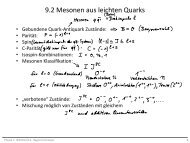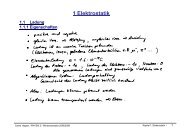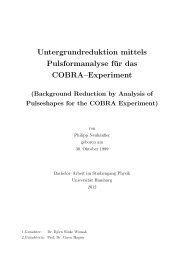Setup of a Drift Tube Muon Tracker and Calibration of Muon ...
Setup of a Drift Tube Muon Tracker and Calibration of Muon ...
Setup of a Drift Tube Muon Tracker and Calibration of Muon ...
Create successful ePaper yourself
Turn your PDF publications into a flip-book with our unique Google optimized e-Paper software.
d[mm]Reco <strong>Drift</strong> Distances201816H_REC_SCATEntries 65217Mean x 1526Mean y 8.932RMS x 515.7RMS y 5.106141210864200 500 1000 1500 2000 2500 3000 3500 4000TDC ChannelFigure 3.12: Scatter plot <strong>of</strong> calculated drift distances d. During calibration the meanvalue <strong>of</strong> d in a given tdc bin gives the corrected drift radius r for that tdc count.<strong>of</strong> the calculated distances in each TDC value bin gives the corrected TDC countto distance relation value. However, for large drift circles, this method suffers fromrelatively low statistics per bin. To obtain better results, both a time <strong>and</strong> spacebased binning is used. For each bin, both histograms are then fitted by a 3 rd degreepolynomial in the region around the bin. For small TDC values, the result from thespace binned fit is used as the new TDC count to distance relation value, whereas forlarge TDC values the parameter obtained from the time binned histogram is used.For each TDC bin, the distribution <strong>of</strong> residuals can be taken into account toobtain the resolution function. However, one has to take into account, that thereconstructed track might still have some errors <strong>and</strong> represents merely an approximation<strong>of</strong> the true track. This is resolved by correcting each residual by a factor√nhitsn d<strong>of</strong>. The fit has two free parameters, hence n d<strong>of</strong> is simply given by n hits − 2. Allcorrected values are filled into a histogram which is then fitted by a Gaussian. Theresolution for the corresponding bin can then be derived from the σ <strong>of</strong> the fit.3.8 Commissioning: <strong>Muon</strong>s in HamburgThe original purpose <strong>of</strong> the CMT was a three dimensional tracking <strong>of</strong> cosmic muons.After commissioning, the tracker was used to investigate cosmic muons in the laboratoryin Hamburg. The location <strong>of</strong> the laboratory is slightly above sea level. Totest the functionality <strong>of</strong> the detector, reconstructed tracks have been compared toa Monte Carlo simulation based on the muon distribution at sea level. The resultsare presented in the next sections, followed by a brief look at the overall quality <strong>of</strong>the data analysis <strong>and</strong> the resolution achieved by the detector.44





